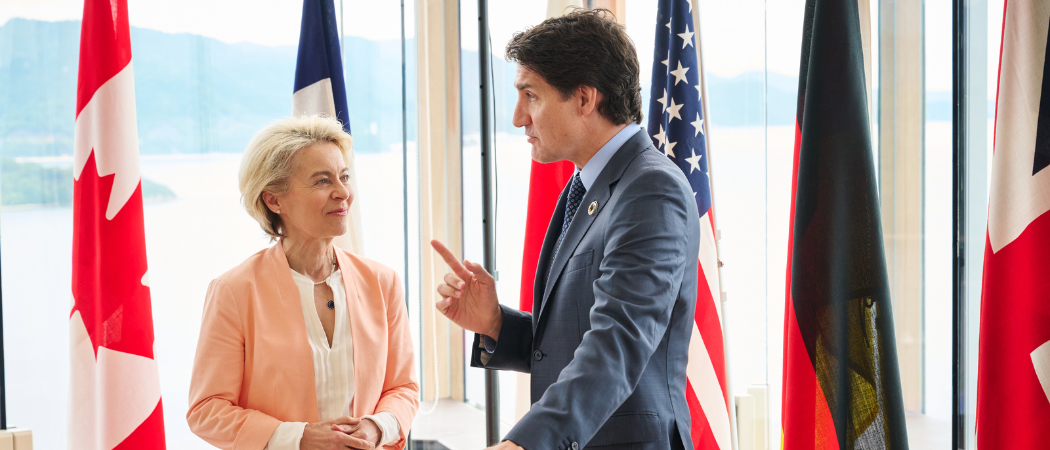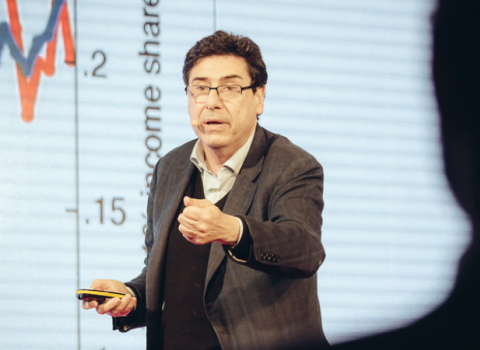Several EU-Canada projects already exist, but joining Horizon should ease the path to many more. However, Canadians are wary of application paperwork - and may be disappointed to find they cannot apply to the European Research Council on equal terms

European Commission President Ursula von der Leyen with Canadian Prime Minister Justin Trudeau. Photo: Dati Bendo / European Union
From the middle of this year, Canada will be associated to Horizon Europe, the EU’s €95 billion research and innovation programme. It will be the second country from outside Europe to join, after New Zealand, as the European Commission opens up the initiative to “likeminded” democracies around the globe
For Canadian researchers, this opens up a world of possibilities – practically a whole new funding agency, if they can get past Horizon Europe’s notoriously low success rates, currently standing at 15.9%.
Some hope that Horizon can offer them latitude that is not available from Canadian domestic agencies, like the ability to fund non-governmental organisation (NGO) partners in their projects. Yet for a country with no history of formal engagement with the EU’s framework programmes, it could be a steep learning curve, with researchers facing an unfamiliar thicket of application and reporting paperwork.
However, there are already several established EU-Canadian joint projects, cobbled together using special funding and application arrangements, which have run the gamut of integrating Canadians into EU funding schemes.
Science|Business spoke to the scientists behind three of them to get a sense of what Canadian researchers, and their European partners, should expect.
Canadian association is “very exciting news,” said Anne Broadbent, the incoming Canadian lead of FoQaCia, a transatlantic collaboration seeking fundamental advances in the understanding of quantum algorithms, that could ultimately lead to breakthroughs in quantum computing.
It involves universities from Sweden, Spain, Portugal, Turkey, Poland and the UK, and three Canadian partners.
But setting up the call that funded FoQaCia was something of an ordeal, said Broadbent, an associate professor in quantum information processing at the University of Ottawa. “This call was the outcome of years of bilateral discussions between Canada-EU,” she said.
FoQaCia, along with two other projects, was funded through a €8 million special joint call between the Commission and the Natural Sciences and Engineering Research Council of Canada (NSERC). Under the terms of this deal, applications were only assessed by the EU, rather than NSERC as well, making the whole process far easier. “A single evaluation process was key in creating a strong bilateral partnership,” Broadbent said.
Under Horizon Europe, Canadian researchers will be able to apply on similar terms, without needing to apply to a Canadian funder as well as the EU, and without the tortuous process of having to set up a targeted joint call each time, as was the case for Broadbent and colleagues.
Steep learning curve
That’s the positive – the seamless, global team building that’s supposed to be a hallmark of EU framework programmes.
The negative, however, is that Broadbent expects Canadian researchers to face a paperwork shock when applying for and completing any Horizon Europe projects.
“I cannot emphasize this enough, and this is one of my major concerns - with Canada's association to Horizon, it will be a very steep learning curve for Canada-based researchers towards complying with the machinery,” she said. Canadian funding, by contrast, has a “relatively light administrative burden, both for submission and reporting.”
What’s more, Europe has developed a whole ecosystem of specialised companies that prepare and manage applications, expertise Canada so far lacks. Fortunately, Canadian applicants are likely to have European partners who are much better versed in this bureaucratic world.
“For the application process, it was absolutely crucial that our European partner – the International Iberian Nanotechnology Laboratory in Braga, Portugal - was well-versed in the Horizon machinery. We tremendously benefitted from this, and it would not be possible to do this on our own on the Canadian side,” said Broadbent.
Flexibilities
But once over the paperwork hurdle, there’s flexibility to EU funding that’s often lacking in Canada, said Anna Triandafyllidou, Canada Excellence research chair in migration and integration at Toronto Metropolitan University, and one of the leaders of GAPS, a Horizon Europe funded global study of return migration.
Grants in Canada typically cannot fund NGOs, think tanks, or work such as research dissemination work by a small company, said Triandafyllidou.
She speaks from her experience as a veteran assessor for EU framework programmes who spent most of her career in Europe before moving to Canada in 2019.
“It's quite restrictive,” Triandafyllidou said. “For me, it’s crazy, because you have to have civil society involvement.”
So it might come as a welcome revelation to Canadian researchers that Horizon Europe projects typically have no such restrictions, and include non-university, fully funded partners as a matter of course.
Another difference that awaits Canadian researchers is that for EU-funded projects, deadlines and aims are much more concretely fleshed out beforehand than in Canada.
“In Europe, once you're funded, you know what you're doing. Everyone knows what they're doing, and they're bound by a contract, a very clear contract,” said Triandafyllidou. Meanwhile in Canada, a lot of this fleshing out happens later. “In that sense there is a bit more risk that our colleagues are not going to deliver,” she said.
Gender Equality Plans
When joining Horizon projects, Canadian universities might also want to check that their diversity policies line up with EU requirements. For example, all partners need to have a gender equality plan to receive Horizon funding.
When applying for funding for the GAPS project, Triandafyllidou discovered that Toronto Met did not actually have a specific gender plan. Instead it had a much broader equity, diversity and inclusion policy.
“In the EU the emphasis is on gender,” she said. “Oftentimes I have to do this translation of the terms.” The Commission has published advice on whether other equality policies count as a gender plan.
Another major difference is that Canadian grants are often designed to train up the next generation of researchers, and are often focused on funding PhD students. However, in some cases this can leave principle investigators with a huge supervision load, and little actual extra money to fund other expenses, several academics said.
“The idea is you're not funding costs [in Canada],” said Triandafyllidou. “You're funding PhD and MA students working part-time to develop the project. It's a completely different model. It's much more labour intensive on the part of PI.”
On the other hand, in Triandafyllidou’s experience, Horizon projects can typically fund at least one full-time postdoctoral student, a much less “labour intensive” model for senior scientists than in Canada.
Just funding students
“We don't get any research funding in Canada, it's just funding to pay students and student travel,” confirmed Michael Pope, an associate professor of chemical engineering at the University of Waterloo, and one of the leaders of 2D-Mature, a Canadian-German project to find applications for graphene and similar ultra-thin materials. “There’s no money to do the research.”
2D-Mature isn’t funded through Horizon Europe, but by the German Research Foundation and NSERC.
But Pope is hopeful that association will bring fresh money to the Canadian system. “I would be excited because obviously we'd have access to probably significantly more funding than we have available in Canada,” he said.
Pope also hopes that the EU will mandate that Canadian PhD students are not charged tuition fees when working on Horizon projects – a major bugbear of his, because these fees eat up a “big chunk” of the project funding. “If we could just eliminate tuition for grad students, that would be a game changer,” he said.
However, one of Pope’s German colleagues on 2D-Mature, Gerd Bacher, is much less keen to apply for Horizon money if the team embarks on future projects. “The administration issues are impossible,” said Bacher, a professor at the University of Duisburg-Essen. “Why should I waste my time and apply for [a programme with] a 10% success rates?”
ERC confusion
All the Canada-based scientists who spoke to Science|Business are excited at the prospect of accessing Horizon Europe for fundamental research funding, which they say is lacking at home.
They may be disappointed, however – association does not include full access to the European Research Council, the EU’s funder of basic research. Canadians can still apply, but as before, have to relocate for at least 50% of their time to Europe to take up an ERC grant.
Even framework programme expert Triandafyllidou was unaware that Canada has only negotiated access to Pillar II of the programme, which tends to be more applied, focusing on global and industrial challenges.
There’s a question over how many Canadian researchers actually realise Horizon Europe, or at least part of it, will soon become an option.
“It offers different types of grants. It offers a whole new range of partnerships and networks,” she said. “And of course, it will offer much more visibility”.
But, Triandafyllidou acknowledged, some of her colleagues in more remote Canadian universities remain unaware of impending association.





 A unique international forum for public research organisations and companies to connect their external engagement with strategic interests around their R&D system.
A unique international forum for public research organisations and companies to connect their external engagement with strategic interests around their R&D system.